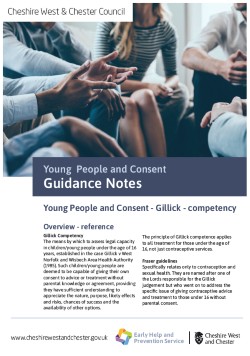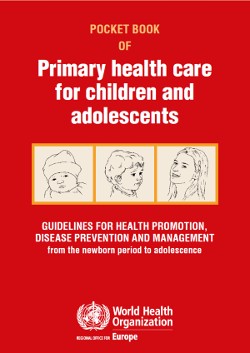Guide to children’s participation in decisions about their health
Reaching a decision

Determining a child’s best interests
Reaching any decision concerning a child’s care must be based on what is in the best interests of the child. Assessment and determination of the child's best interests must be centred on the individual child and include consideration of the child’s health needs, their own views, safety, protection, care and overall well-being (UNCRC General comment No. 14 (2013) on the right of the child to have his or her best interests taken as a primary consideration, article 3, paragraph 1).
Many aspects should be given due weight to assess and determine a child’s best interests. However, there is no fixed recipe for every situation. Respect for the best interests of the child and, indeed, respect for children’s participation requires a balance between what professionals (ideally all professionals working in a multidisciplinary team with an integrated approach to care) and parents consider to be the best for the child, given the illness or health problem, available treatments, effects and so on; and the child’s views on what is ‘best’ for them. Exploring children’s preferences, family culture (including participation culture), past experiences and other factors will help professionals support and facilitate the best possible decision for the child. Consideration must also be given to the children’s right to an open future, meaning that preference should be given, when possible, to options which least restrict their future choices.
General Medical Council Guidance - United Kingdom
12. An assessment of best interests will include what is clinically indicated in a particular case. You should also consider:
- the views of the child or young person, so far as they can express them, including any previously expressed preferences
- the views of parents
- the views of others close to the child or young person
- the cultural, religious or other beliefs and values of the child or parents4
- the views of other healthcare professionals involved in providing care to the child or young person, and of any other professionals who have an interest in their welfare
- which choice, if there is more than one, will least restrict the child or young person’s future options.
13. This list is not exhaustive. The weight you attach to each point will depend on the circumstances, and you should consider any other relevant information. You should not make unjustified assumptions about a child or young person’s best interests based on irrelevant or discriminatory factors, such as their behaviour, appearance or disability.
Consent, assent and dissent
For certain treatments or interventions, through protocols specified by law, professionals will need to obtain the formal agreement of parents or of the child themselves.
According to the Oviedo Convention, the term “consent” is used when the formal agreement is given by the person concerned by treatment or act, whereas the term “authorisation” refers to the formal agreement given by the parents/legal representatives or body provided by law.
According to the World Health Organization (WHO), informed consent “relates to the formally expressed (usually written) agreement or permission for any health intervention, such as vaccination, effective surgery, choosing or terminating a treatment. ” (Pocket book of primary health care for children and adolescents: guidelines for health promotion, disease prevention and management from the newborn period to adolescence, p.666).
As mentioned in section "Relevant domestic law(s) in Council of Europe member states", in national legislations, children’s right to informed consent to treatment can be based on age criteria. Additionally, another concept has emerged, that of children’s competency.

The notion of children’s competency was discussed in a case brought to court in the UK in 1986, where the court’s ruling stated that “whether or not a child is capable of giving the necessary consent will depend on the child’s maturity and understanding and the nature of the consent required. The child must be capable of making a reasonable assessment of the advantages and disadvantages of the treatment proposed, so the consent, if given, can be properly and fairly described as true consent.”
The so-called Gillick competency grew in importance and is increasingly recognised as a determining factor for giving children the right to consent to treatment. Assessing competency is left to the healthcare professionals and there is no universally agreed-upon method to do so. However, guidance will usually include assessing children’s ability to understand their situation, to weigh the different options available to them and to understand the consequences of each.
The emergence of methods and practices to assess competency have been intended to increase child inclusion, participation and rights in decision-making. This places a duty on health professionals to ensure that children are given appropriate information in a way that is understandable to them in order to facilitate their competence. It also requires that health professionals recognise that some children may require information in different ways in order to achieve the same level of understanding and competence.
Children can also, according to national legislation, provide their assent or express their dissent. The terms assent and dissent generally describe when children give their agreement or disagreement to a treatment, in situations where they do not yet have a legal right to give their consent.
If children are considered capable of assent, their assent should be sought in addition to parental authorisation.
In many European countries, written authorisation of parents in addition to the child’s own assent is required.
In order to ensure that children can exercise their right to consent or assent, hospitals and other health services should put in place different measures, including:
Adopting a hospital or health service consent policy, reflecting national legislation
Ensuring that health professionals are aware of this policy
Promoting capacity building of professionals to ensure they have the knowledge and competencies to engage and involve children in the decision-making process in a meaningful way and that they ask for their consent to treatment whenever it is required
Engaging with children regularly to assess existing policies and practices, as a way to improve these and also children’s experiences of care.
Taking into account the national legal framework, seeking agreement should put in balance the emerging capacity of an adolescent for independent decision-making with the need for continued special protection as provided by the parents/legally designated representative in compliance with national laws. The specific aspects of disclosure to parents of information concerning adolescents should be made clear to the adolescent concerned.
For younger or non-verbal children who are not able to raise or express verbal objections, any signs of resistance or protest should be identified and discussed with the parents to assess and recognise whether the behaviour is merely an expression of an acceptable burden or can be considered a concern on intervention continuation. It should also be recognised that for many children, the people best placed to understand or interpret non-verbal indications will be the parents.
In all circumstances, and regardless of the outcome or direction of a decision, the conclusions of any decisions made should be carefully and kindly explained to the child.
Guidance on assessing a child’s competency - Cheshire West & Chester Council - UK

To be considered competent, a child should have:
- The ability to understand that there is a choice and that choices have consequences
- The ability to weigh the information and arrive at a decision
- To communicate that decision
- A willingness to make a choice (including the choice that someone else should make the
- decision)
- An understanding of the nature and purpose of the proposed intervention
- An understanding of the proposed intervention’s risks and side effects
- An understanding of the alternatives to the proposed intervention and the risks attached to them
- Freedom from undue pressure
- The ability to retain the information
WHO guidance on assessing the competence of children

8.2 Competence, consent and confidentiality
When caring for adolescents the following three principles enshrined in the United Nations Convention on the Rights of the Child (p.4) need to be considered:
Assess competence:
Competence is a legal concept that grants the right to make an autonomous decision (i.e. a decision taken without third-party authorisation, i.e. from parents or guardians). While competence is a legal concept, capacity is a clinical concept. It is defined as the ability of an individual to form an opinion and make an informed and autonomous decision, notably in respect of health and health care. Children and adolescents’ decision making capacity develops with age: as they mature cognitively they can begin to make autonomous decisions regarding more complex issues. Some countries set an age limit for the competence of minors (often at 14, 15 or 16 years), but others leave the assessment of competence to the health care provider. In some instances, a provider can even declare an adolescent competent to make a decision in his or her own best interest before the adolescent attains the age defined by national laws as that of legal competence.
- Be aware of your country’s legal framework concerning health care.
- Establish an empathetic relationship with the adolescent.
- Assess the adolescent’s competence and decision-making capacity. Evaluate the adolescent’s ability :
- To understand different aspects of the given situation
- To choose between different options, and appreciate their differences
- To understand the outcomes resulting from different decision(s).
- Reassess the adolescent’s cognitive skills regularly, as they may develop from one encounter to the next.
Pocket book of primary health care for children and adolescents: guidelines for health promotion, disease prevention and management from the newborn period to adolescence. Copenhagen: WHO Regional Office for Europe; 2022. Licence: CC BY-NCSA 3.0 IGO. Page 666
WHO Pocket book of primary healthcare for children and adolescents


